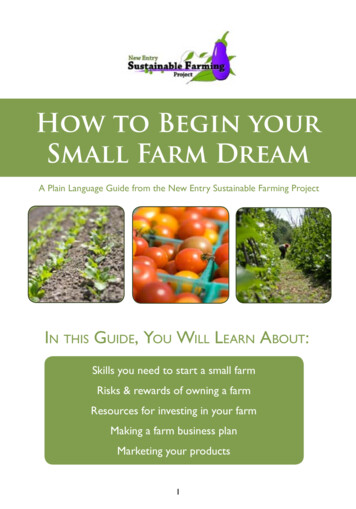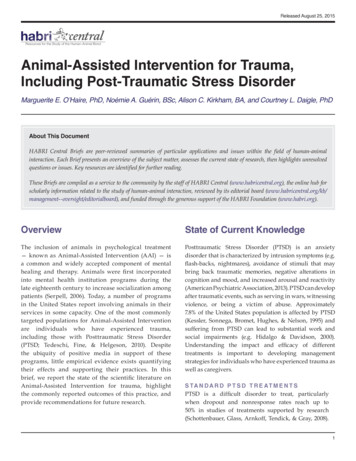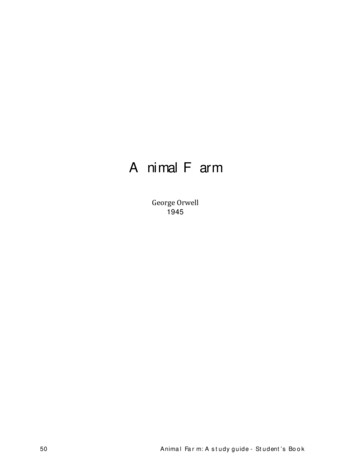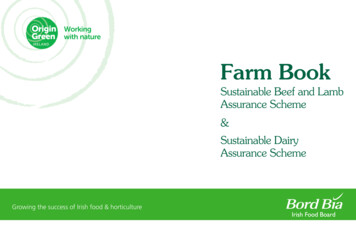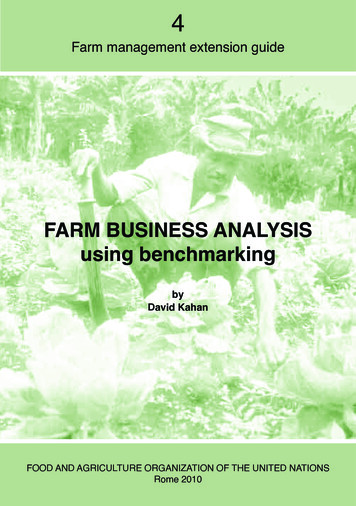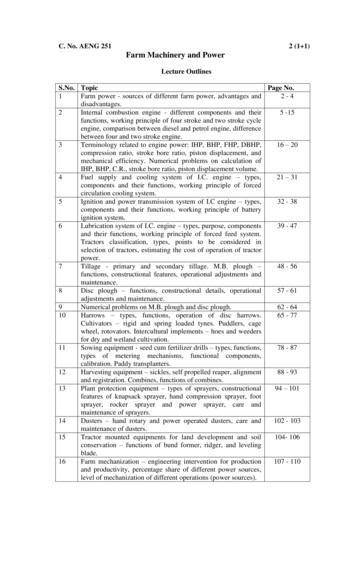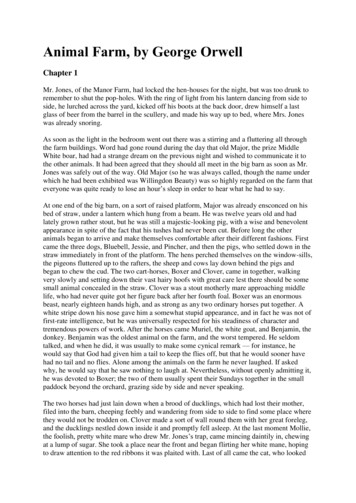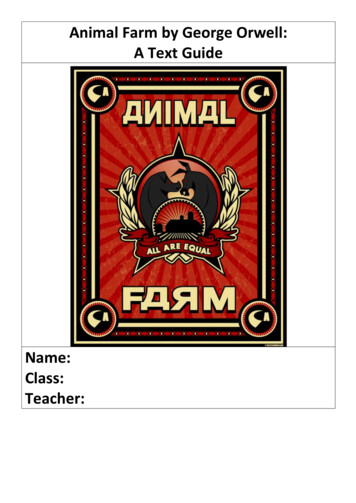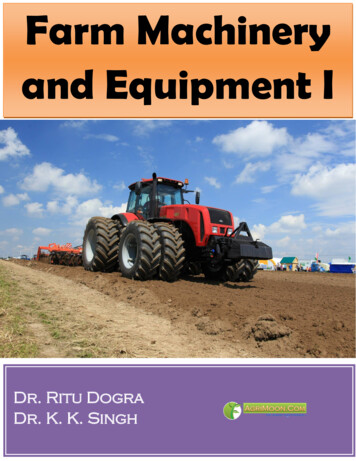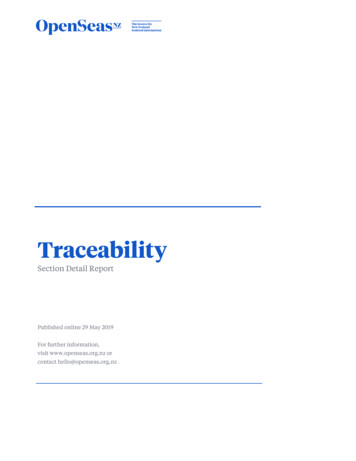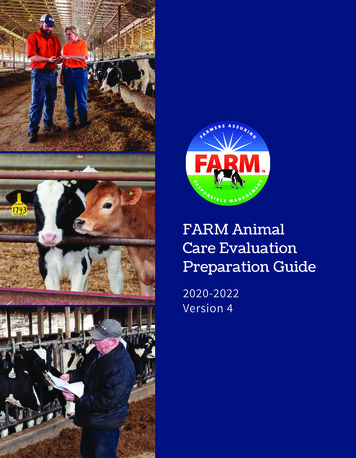
Transcription
FARM AnimalCare EvaluationPreparation Guide2020-2022Version 4
About FARM Animal CareConsumers today are more interested than ever before in theirfood: how it’s produced, its safety and wholesomeness, who isproducing it and how animals are treated. The National DairyFARM Program: Farmers Assuring Responsible Management isearning the trust of everyone who makes dairy a part of theirday by setting the highest standards when it comes to animalcare, workplace settings, and environmental and antibioticstewardship. Open to all farms, milk processors and cooperatives,FARM helps ensure the success of the entire industry bydemonstrating to our customers and consumers that U.S. dairyfarmers are committed to producing the best milk with integrity.National Milk Producers Federation (NMPF) with support fromDairy Management, Inc., established the FARM Program in2009. Through the Innovation Center for US Dairy, the dairycommunity has aligned behind FARM as the industry-widesocial responsibility program.The FARM Animal Care Program demonstrates that dairyproducers are committed to taking excellent care oftheir animals and producing safe, wholesome milk by: Detailing science-based animal care guidelines thatevolve with the latest dairy research Providing on-farm evaluations by trained evaluators whowork with farmers to identify strengths and, if necessary,outline improvements Ensuring the integrity of the program with third-partyverification by qualified dairy experts who evaluate arepresentative percentage of farms each year todemonstrate that FARM is working as intendedFARM Animal CareDOES: Create a framework andfoundation for on-farmanimal care Create a culture ofcontinuous improvement Is a snapshot of farmmanagement practices Require producermonitoring, oversight andactive on-farm participation Rely on science, and is facilityand size neutralFARM Animal CareDOES NOT: Ensure a certain on-farmculture Replace supervision andmanagement of employees Guarantee perfection or thatbest management practicesare followed Eliminate challenges Eliminate threats toconsumer trustFARM Animal Care GuidelinesThe National Dairy FARM Animal Care Programstandards are formally revised every three yearsthrough a strenuous, year-long process.Who Drafts and Approves FARMAnimal Care Program Guidelines?Guidance, Input &AmbassadorshipApprovalRecommendationsFarmer Representationwithin GroupFarmer Advisory CouncilDedicated producers serving a three-year term who provideguidance and input for consideration in FARM’s ongoing andfuture development. Members work to champion FARM withinother organizations, communities and throughout the industry.100%NMPF Animal Care Technical Writing GroupDairy farmers, Farmer Advisory Council chairperson and vicechairperson, and veterinarian membership representationwho review the latest research and aggregated FARM AnimalCare Program data, and provide recommendations to theNMPF Animal Health & Well-Being Committee and NMPFBoard of Directors.25%NMPF AnimalHealth & Well-BeingCommitteeMembers are appointedby interested NationalMilk Producers Federationmember cooperatives. Thecommittee coordinates NMPF’sparticipation in animal healthcontingencies, includingdevelopment of animalhealth research priorities, andprovides oversight for theFARM Animal Care Program.Innovation CenterAnimal CareCommittee25%Open CommentPeriod 370 CommentsReceived25%45%NMPF Board of Directors60%
Second-Party EvaluationThird-Party VerificationA Second-Party Evaluation is an external review andassessment of on-farm animal care practices for a participatingdairy farm facility based on the National Dairy FARM Programguidelines. Facilities participating in FARM Animal CareProgram must undergo a Second-Party Evaluation atleast once every three years. Evaluations are not to beconducted unannounced.All facilities that have had a Second-Party Evaluation aresubject to Third-Party Verification. Contracted with the FARMAnimal Care Program, Third-Party Verifiers conduct verificationson a representative percentage of participating facilities eachyear to provide statistically valid data regarding adherenceto FARM Program guidelines. This process demonstratesthe program’s integrity by program participants ensuringSecond-Party Evaluators consistently implement the FARMProgram. Third-Party Verifiers conduct their assessmentutilizing the same standards as Second-Party Evaluators.Verifications are not to be conducted unannounced.What Facilities Complete Second-Party Evaluations?Second-Party Evaluations are conducted on each dairyfacility with lactating dairy cows that is a member, patron,contractor or direct shipper of any organization that hassigned a FARM Animal Care Participation Agreement.Who Conducts Second-Party Evaluations?Second-Party Evaluations are conducted by certified individualswho complete and pass annual in-person training.Before attending a training, Second-Party Evaluators arerequired to meet minimum prerequisites including acombination of five years of education and/or on-dairy farmindustry experience, a written application and completionof an in-depth interview. To read more about the evaluatorprocess, visit the FARM website: nationaldairyfarm.comWhere are Third-Party Verifications Conducted?Every six months, a random sample of all eligible facilitiesis selected from a pool of the facilities that were evaluatedduring the previous six months.Who Conducts Third-Party Verifications?The National Dairy FARM Program contracts with an auditingfirm to facilitate the FARM Animal Care Program verificationprocess. Individuals approved to conduct verifications mustmeet the outlined requirements for Second-Party animalcare evaluators in addition to having an extensive auditorbackground. All Third-Party Verifiers must complete annualin-person training.During an Evaluation a CertifiedSecond-Party Evaluator will:Continuing education recordsSigned veterinarian documentationWritten protocolsCow treatment recordsDuring a Verification a CertifiedThird-Party Verifier will:Review Observe Animals Facilities Animals FacilitiesVerify Observed actions are consistent with writtenrecords and protocols Observed actions are consistent with writtenrecords and protocolsCreate Any corrective action plans if certainstandards are not met If required, corrective action plans if certainstandards are not met* Continuing education recordsSigned veterinarian documentationWritten protocolsCow treatment records*Verifiers are ONLY permitted to create required action plans outlined in the FARM Animal Care Program Version 4 guidelines.
Customer Outreach FocusThe National Dairy FARM Program assists FARM Animal Care Program participants in providing necessary aggregated dataand proof points to dairy customers (i.e. retail, food service, package goods, etc.) to maintain confidence within the dairysupply chain.FARM develops multi-level relationships and provides impactful business materials to dairy customers to ensure the dairyindustry is top of mind when customers have questions about on-farm animal care practices and in the development of anyprocurement policy or sourcing guidelines. The program demonstrates the dairy community’s commitment to stewardshipand social responsibility through event-based dialogue and supply chain alignment.After the Evaluation or VerificationProgram ExpectationsDairy Producer Adhere to outlined FARM Animal CareProgram standards Sign Pledge of Participation during Second-PartyEvaluation, establishing an understanding ofstandards and verification process- Required for good standing Provide necessary written protocols andrecords for evaluator or verifier to review Assist evaluator or verifier as needed incompleting the evaluation Complete any corrective action plans withinthe identified timeline(s)Evaluator & Verifier Follow all safety guidelines and employ properbiosecurity protocols set forth by the FARM AnimalCare Program as well as the individual producer Maintain and safeguard the confidentiality of thedairy facility’s information Properly communicate evaluationexpectations to producers Assist the dairy facility in completingany corrective action plans Coordinate scheduling betweenproducer and verifier Evaluators should attend Third-PartyVerifications if possible Be polite and courteous Follow up and resolve necessaryaction plans created by verifierEvaluation or Verification FeedbackThe FARM Program values feedback from the dairycommunity as it influences future standards andprogrammatic processes. After participating in aSecond-Party Evaluation or Third-Party Verification, weencourage all dairy producers and managers to completea feedback form found on the FARM Program ARM Database AccessAll dairy facilities have access to review their completedevaluations, verifications, and active and past correctiveaction plans within the password-secured FARM database.Facility representatives in need of creating an accountwithin the FARM database should reach out to theirFARM Second-Party Evaluator.Completing Corrective Action PlansIf during an evaluation or verification any corrective actionplans were created, dairy facility representatives shouldwork closely with a Second-Party Evaluator to adhere to anytimelines to complete any identified actions.
FARM Animal Care Program Version 4 StandardsDocumentationReviewed Protocols and Verified Effective ActionsTo be reviewed during a Second-Party Evaluationor Third-Party VerificationThe facility will be evaluated for the presence of the following writtenprotocols as well as their effectiveness in action. All written protocolsshould be translated as needed into a language understood by allindividuals with assigned animal care responsibilities. Signed Cow Care Agreements#†Non-Immediate Family Members# Onesigned agreement from each employeewho is 18 years or older with animal careresponsibilities documented annually.Immediate Family Members† One signedagreement from each employee who is 18years or older with animal care responsibilitiesdocumented annually OR a documentsigned by a family representative takingresponsibility for explaining animal careexpectations to remaining family memberswho are 18 years or older.Herd Health PlanReviewed annually by the Veterinarian of Record# Pre-Weaned CalvesProtocol including:How calves are moved#How colostrum is provided#How milk/milk replacer isprovided#Feed and water are provided byday three#Disbudding of calves prior to 8weeks of age#Pain mitigation used fordisbudding†- Pain mitigation is expectedto be used when disbuddingcalves for any method(cautery, paste, etc.)- It is expected that producerswork with their veterinarians todetermine the appropriate painmitigation to use for disbuddingImmediate family member is defined as agrandparent, parent, in-law, spouse, partner,sibling, child or grandchild of the legal guardian(s)or legal owner(s) of the dairy operation. Veterinarian-Client-Patient Relationship#VCPR to be signed annually by facilityrepresentative and Veterinarian of Record. Continuing Education Records#†Job-specific continuing education for non-family#and family† employees if they have animal careresponsibilities that include:StockmanshipPre-weaned calf careNon-ambulatory animalsEuthanasiaDetermining animals are fit to transportCriteria for the identification ofanimals to be euthanized#Euthanasia techniques that followthe approved methods of AABPand/or AVMA#How carcass disposal is conductedusing an appropriate method# Treatment of Common DiseasesMastitisMetritisMilk feverKetosisDisplaced abomasumPneumoniaDiarrhea Lameness Prevention and Treatment Difficult Calving (Dystocia) Protocol Vaccination Protocols that specify: Non-Ambulatory AnimalsProtocol including:How non-ambulatory animalsare moved#What prompt medical care isprovided#Outlines that non-ambulatoryanimals are providedwith access to feed, water,protection from heat andcold for typical climaticconditions, isolation fromother ambulatory animals andprotection from predators# Permanent Written or Electronic DrugTreatment Records are Maintained†StockmanshipDate of treatmentAnimal treated identificationName of treatmentDisease/condition being treatedDosage administeredRoute of administrationDuration of treatmentSpecified withdrawal times for milk andmeat to ensure food safety Euthanasia Protocol including: Fitness to TransportProtocol# including:#Unmet standard results in Mandatory Corrective Action PlanAge(s)/stage whenvaccination givenProduct usedDosage administeredRoute of administrationWithdrawal times Milking Procedure Protocol Emergency Action or Crisis PlanExamples: employee injury, biosecurity, naturaldisasters, temperature extremes, contagiousdisease outbreak, power failure, manure spills, etc. Biosecurity Protocol Pest, Fly and Parasite ControlDefinition of animals that areeligible to be marketedOutlines adherence to milk andmeat withdrawal times†Unmet standard results in a Continuous Improvement Plan
Animal ObservationsDuring the evaluation, the following animal observations will be conducted by the evaluator.All Age ClassesNo routine tail docking Each animal is identified with a tamper-resistant individual animal IDOutcomes-Based Animal ObservationsHygieneBody enTails†Benchmarkto Meet90% or moreobserved animalsscore 2 or less onthe FARM ProgramHygiene Scorecard99% or moreof observedanimals have a bodycondition score of 2or greater on FARMBody ConditionScorecard95% or more of thelactating herd score2 or less on theFARM LocomotionScorecard95% or more ofthe lactating herdscore 2 or less onthe FARM HockScorecard95% or more ofthe lactating herdscore 2 or less onthe FARM KneeScorecard95% or more oflactating animalsdo not havebroken tailsLactating Cows333333Pre-WeanedCalves33(3 days of ageand older)(3 days of ageand older)Post-WeanedHeifers33Pre-Fresh Cowsand Heifers/DryCows3(heifers, bulls, steers)Facility ObservationsDuring the evaluation, the following facility observations will be conducted by the evaluator. Posted Emergency Contact Information Facility DesignClean, soft, dry, well-lit and well-ventilated calving areaMethod of daily exercise for all age classesProtection from heat and cold for typical climatic conditionHousing allows all age classes of animals to easily stand up, lie down, adopt normal resting postures and have visualcontact with other cattle without risk of injuryResting area for all age classes of animals that is clean, dry, provides traction at all times when away from the milkingfacility and does not pose risk of injuryFacilities designed to prevent injuries, slips and falls of animalsPlease reference Second-Party Evaluator, FARM Animal Care Program Manual and/or FARM website to confirm if anycontinuing education, documentation, protocol or action meets the outlined standard. Unmet standard results in an Immediate Action Plan
Corrective Action PlansFailing to meet certain FARM Animal Care Program Version 4 standards will trigger one of the following corrective actions plans.FARM Program Second-Party Evaluation ConductedImmediate Action Plans IAPStandard must be met immediatelyIMMEDIATE ACTION ISSUEDWithin 48 Hours: On-Site Follow-UpIssue Resolved:Facility is deemed FARMCertified with follow up at1 week, 1 month and3 monthsIssue Not Resolved:Conditional DecertificationImmediate Action Plans require that the standard is met immediately.Failure to meet this standard will result in the facility being placed onConditional Certification for 48 hours or less once the standard is met.If after the 48-hour Conditional Certification the facility continues to notmeet the standard, the facility will be Conditionally Decertified until thestandard is met.The program participant (the co-op or processor through which thefarm is participating) will be delisted from FARM if they continue toprocure milk from a Conditionally Decertified facility. If the facility isplaced on Conditional Certification for an IAP, there is the expectationthat the facility is followed up with at one-week, one-month andthree-month intervals to ensure the standard is met.Mandatory Corrective Action Plans MCAPFARM Program Second-Party Evaluation ConductedRequires that the standard is met within nine months or lessMandatory Corrective Action Plans require that the standard ismet within nine months or less as determined by the programparticipant. Failure to meet these standards within this allottedtimeframe will result in the facility being placed on ConditionalCertification leading to Conditional Decertification if standards arenot met after the designated timeframe. The program participant(the co-op or processor through which the farm is participating)will be delisted from FARM if they continue to procure milk from aConditionally Decertified facility.MCAP ISSUEDWithin 9 Months: On-Site Follow-UpIssue Resolved:CertifiedIssue Not Resolved:Conditional CertificationWithin 60 Days:On-Site Follow-UpIssueResolved:CertifiedIssue NotResolved:ConditionalDecertificationContinuous Improvement Plans CIPFARM Program Second-Party Evaluation ConductedRequires that improvement toward meeting thestandard must be met within three years or lessCIP ISSUEDWithin 3 Years: On-Site Follow-UpIssue Resolved:CertifiedIssue Not Resolved:Conditional CertificationWithin 60 Days:On-Site Follow-UpIssueResolved:CertifiedIssue NotResolved:ConditionalDecertificationContinuous Improvement Plans require that action hasbeen taken to meet the standard within a minimumof three years or less as determined by the programparticipant. Failure to meet this standard within thisallotted timeframe will result in the facility being placedon Conditional Certification leading to ConditionalDecertification if standards are not met after the designated timeframe. The program participant (the co-op orprocessor through which the farm is participating) will bedelisted from FARM if they continue to procure milk froma Conditionally Decertified facility. FARM Animal CareProgram evaluators may create CIPs for additional areasbeyond the Version 4 standards if deemed necessary.
ResourcesPR OP ER CAR E FORNON-AMBULATORY COWSCOM MONCAU SES5 MsPRE VEN T1to preventming a balanced rationEnsure cows are consuionmanage body conditmetabolic disease andgto rise soon after calvinable2 Ensure cows areal activitiesdaily for any abnorm3 Observe cowsressare trained in low-stly4 Ensure employeesalleyways are properMSymptoms: dull/weak;Who; is authortrembling/twitching transport for ized to make the decision toculling or other purposes?temperature below101F; cold, droopy earsMThe National Dairy FARMtrainingsanimal care employeed and should be calledIdentify who is trainecow situationin a non-ambulatoryannual animal careProgram requiresThe National Dairy FARMemployee trainingsd to properly move2 Have a team traineeragcowryanbulatoa non-amfor appropriater/MCare Reference ManualOwner down cowsRefer to the FARM Animalequipment to maneuveFarmmeasures when usingp:e:ZimNary cow protocolwritten non-ambulato The National Dairy FARMate:managing non-ambulatorySts:written protocols forAddreshospital areaFarm4 Have an identifiednal):City:(optiorCALMINbeREMA5Numises IDPremZip:riannariVeteate:is bestStg at least 6” deep – sandbeddine deep1 Providaway from cowsName:from the elements andProvide safe shelterare2the that do not tip over andrfotubsCity:inwateredday3 Put feed andtablishbility at least twice aR) is esName:reach - check availaCPeasywithinalClinichip (Vpast legol or roll her onto hertions r party.protocmsent or nrfrober:usingprepropet Relahe the cow and hisnariaatien ed4by eitLifte Numferit-Ptoonardes VetPhhimseltwicelf ofsiden-Clienin regcharg a daycancelCAR Etoiahaotherrever dis may bring im of right, on bee untilterinarorducer ses and forarian about a propeclalid Ve ain in forccould yourht orherd veterinofPR, Pro y releaConsult withducerat a vaany rig the termsthe VC , hereb5remnt ofthat Pro sly waives d fromforrtify th r and willthe cowlishme ts and heirs in equity,planitteby ceentexpresestaborenen omcertreatmI hered ownet orand the assigns, ag nds, at law m. Produor, bee listementpresens,t or MansNeverthisucargelfgence, ovethe FARsors,ngdamation oflf of its ever dischn from ough ignorabehaexecu s, predeces disputes,may briand forM, onficatiold orUponm.ivens,s thrqualiactioentatPR, FAR y releases t FARM cou M prograard haor disrepres all claims,rebthe VCFARh regthation in,nt ofdtes, he in equity,in sucm thence,lishme and affiliaany an ’s participa any claimortion fro gh ignoraestabttscers, at law disqualifica has throud theagenProdufter thamandornt anigns,hereas or de ipation in, such regards, assreemegeAgnt.”sorassertsmamecesinthirees, suc’s partic y claimtes, dation ofthis Agexecu predecessor tions, dispu or Producer r that an;ftes,, uponVCPRims, achereatativedition“In ad al represen y and all cla tion in the ht to assert ment.reeanrticipa im of rigpast leg rian fromthis Agn’s pananaria y right or cla terms ofVeteriVeteritheives anard tod fromin regsly wa en omitteresexpbeFARMerror,ght oroversiHow are family andnon-family employtrained to identifyeesanimals fit to transport?MILK FEVE RWhat type of transportation is utilizedtotransport?Program requires annual1NSPORTFitness to TransportHerd Health Plancow handling and thatt cows from slips andmaintained to prevenfeet and leg supportfalls and for properentt-Pati Formn-Clienarian ValidationriVete onshipPLA NRelatiFITNESS TO TRAObjective: To ensuresuitability for ananimal to be culledand transportedAdditional Objectto market.ives:6TOXI C MASTITISHow are reasonsfor culling recordSymptoms: dull/weak;ed?estemperature extrem(high or low); sunkenAntibiotic Steweyes; abnormal milk;ardshipg are theWhofamily and non-faheat, pain and swellinemployrs ees trained to ensure milyof one or more quartethatwithdrawalMtimes have beenmet orexceeded beforeanimals are marketed?Where are treatmRITISent records withTOXI C METwithdrawal timestreatments recorded?Symptoms: dull/weak;Doesesthe treatment record includetemperature extrem: Treatment date(high or low); sunken Animal identificationd Dosageyes; watery, coloreeor cloudy vagina l Route of administration andexpected durationdischarge and odorfor MDAM AGE Duration of therapyHow are animalabnormal s that have a milk or meatSymptoms:withhold clearlyg identified to reduce theswellinangle and/orchanceof violation and protectfoodsafety?to limb; suspector dislocation;fractureAdditional ProtocolsSpecifications:paralysisMMAS SIVEINFE CTIO NSymptoms: dull/depressed; sunkeneyes; temperatureextremes (high or low);difficulty breathingTO STA ND IFASS IST THE COWinitial treatmenta physical exam andand she:have been completed33333For more protocoltemplates, visit www.nationaldairyfarm.comTMIs bright and alertlingIs not severely trembor twitchingceDoes not have evidenof severe diseaseDoes not appearseverely weaklAppears to have normaand functioning limbsWithdrawal timefor milkIndividual who admini and meatstered thedrugTALDrug usedMUSC ULOS KELEFor additional resources.com.visit nationaldairyfarm 2018 National MilkProducers FederationMI LKDR UG RE & DA IR Y BE EFSI DU EPR EV ENREFERTI ONENCE MANUAL2019The FARM Program works closely with industry stakeholders to curate and developon-farm animal care resources in order to meet FARM Animal Care Program standards.To learn more about the FARM Program, access protocol templates or training aids,visit the FARM website: www.nationaldairyfarm.com 2 0 2 0 N AT I O N A L D A I R Y FA R M P R O G R A M . A L L R I G H TS R E S E R V E D .
assessment of on-farm animal care practices for a participating dairy farm facility based on the National Dairy FARM Program guidelines. Facilities participating in FARM Animal Care Program must undergo a Second-Party Evaluation at least once every thre

